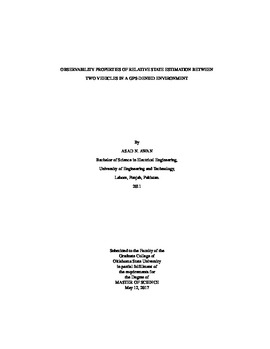| dc.contributor.advisor | Sheng, Weihua | |
| dc.contributor.advisor | Bai, He | |
| dc.contributor.author | Awan, Asad Nisar | |
| dc.date.accessioned | 2018-06-13T16:19:47Z | |
| dc.date.available | 2018-06-13T16:19:47Z | |
| dc.date.issued | 2017-05-12 | |
| dc.identifier.uri | https://hdl.handle.net/11244/300049 | |
| dc.description.abstract | One of the practical problems encountered in the coordination and cooperation of multi-UAS systems is to obtain the position and the orientation information of the neighboring vehicles while working in a GPS-denied environment. The research work is based on estimating the relative states between multiple vehicles and analyzing their observability properties. It has been divided into two sub-problems. First, the relative heading estimation between two unmanned aerial systems in the presence of constant disturbances is considered in a GPS-denied environment. Second, the observability properties of relative state estimation between two vehicles in bearing-only scenarios is investigated.In the first problem, the nonlinear observability rank condition is employed and observability conditions of the relative states are established when the relative position between the two UAS is measured. In the first scenario, it is shown that if a UAS (say UAS 2) measures the position of another UAS (say UAS 1), the relative states between the two UAS, including the relative heading and the relative wind, and the airspeed and the heading rate of UAS 1, are locally weakly observable. The observability result holds even when UAS 2 is stationary. In the second scenario, observability properties of the relative states when UAS 1 is tracking a ground target using a feedback control are investigated. It is proved that the relative states and the range between UAS 1 and the target are locally weakly observable. The observability of the target range implies that UAS 2 can estimate the target position without observing the target.In the second problem, global observability of the relative state estimation problem in bearing-only scenarios is investigated. It is assumed that one vehicle is equipped with a monocular camera sensor to obtain bearing measurements of the other vehicle. Global observability properties are investigated when the linear speeds and the angular velocities of both vehicles are constant. Unobservable scenarios when both vehicles are cruising or orbiting are also illustrated. It is further proved that the relative state is observable without communication between the vehicles. When both vehicles are orbiting, conditions on the angular velocities of the vehicles are developed to ensure observability. | |
| dc.format | application/pdf | |
| dc.language | en_US | |
| dc.rights | Copyright is held by the author who has granted the Oklahoma State University Library the non-exclusive right to share this material in its institutional repository. Contact Digital Library Services at lib-dls@okstate.edu or 405-744-9161 for the permission policy on the use, reproduction or distribution of this material. | |
| dc.title | Observability Properties of Relative State Estimation Between Two Vehicles in a GPS-Denied Environment | |
| dc.contributor.committeeMember | Teague, Keith A. | |
| osu.filename | Awan_okstate_0664M_15072.pdf | |
| osu.accesstype | Open Access | |
| dc.description.department | Electrical Engineering | |
| dc.type.genre | Thesis | |
| dc.type.material | text | |
